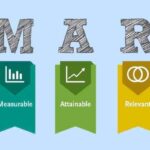Personal Development Plan (PDP) plus template

Personal development plan: this article explains the personal development plan (PDP) in a practical way. Next to what it is, this article also the benefits, how do I write it, a The full guide and personal development plan template to create a personal development plan and started and get closer to your goals. Enjoy reading!
What is a personal development plan?
A personal development plan is an approach, or action plan, through which you can determine the following:
- Your personal development goals (development opportunities)
- Strengths and weaknesses
- The areas that need improvement and development to achieve your goals
- What actions are needed to achieve your goals
- How to monitor progress
- Which things can hinder progress
The personal development plan, PDP in short, is a form of self-evaluation and self-reflection that is frequently applied in education, but also in the personal and professional life of many individuals.
Developing and executing a PDP is a useful method of self-development for many people.
Benefits of a personal development plan
The benefits of using a PDP include:
- Developing clear SMART goals both short term goals and long term goals
- Improving your employability in your work environment
- Improving performance
- Increasing your motivation
- Improving your mental well-being
- Reducing stress
- Contributing to your IKIGAI
- Maximizing your potency
Many people see personal development as a train journey from point A to point B. In reality, a career and your development is not at all like a train journey: you stop several times, get off and on again at sometimes unforeseen moments.
Whether it’s your personal career or your personal life, it’s good to occasionally assess your situation and reconsider your goals, strengths weaknesses opportunities and threats. Investing in sustainable development and identifying areas for personal development is perhaps the best investment there is.
How do I write a personal development plan? The full guide
All development plans are different, as it is precisely tailored to your personal situation. In education and work life, PDPs have a certain format. Employers can also customize their own versions for employees and have their own procedures and processes to tailor the PDP to their employees.
Regardless of what a PDP is used for, there are some general steps that can help you write a PDP. In any case, these steps include:
- SWOT Analysis
- Career Goals Analysis
- Competency Analysis
- Action plan
- Personal Development Plan Template
Follow the steps below and keep a record of all the output. The result of each of the steps should be used as input for the final personal development plan template.
Step 1: perform a personal analysis
The first step in the process of drawing up a personal development plan is to do a personal analysis. It is important that you have a clear picture of yourself, because only then can the ideal career direction be determined. The personal part of this analysis consists of two parts:
- Getting a clear picture of your personality
- Gaining insights into your own core competencies through a SWOT analysis
Personality
Before you can start planning a career, you need to know where you want to go. That seems easier said than done for many people. By performing a personal analysis you can find out what motivates you, who you really are and where your strengths and weaknesses lie.
To find out, you can use various self-assessment tools, such as the MBTI test (Myers Briggs Personality Test), or the Big Five Personality Test.
SWOT analysis
A SWOT analysis reveals an organization’s strengths and weaknesses and helps identify opportunities and threats to the business. This method can also be applied to your personal situation.
By recognizing your strengths, you can focus your efforts on what you are good at. Understanding weaknesses will help you know what to avoid and what you might need help with.
All input together helps to identify opportunities for your long-term career.
To conduct a personal SWOT analysis, ask yourself a series of questions based on the four quadrants of the analysis. Sample questions are shown below.
Strengths
- What are you really good at?
- For which skills do you receive recognition?
- What skills do you have that others don’t?
- What do you do better than the people you work with?
- What are you most proud of when it comes to your own skills?
- Do you have access to skills, resources, or connections that others don’t?
Weaknesses in the personal development plan
- What are you less good at? What skills do you struggle with in your professional and personal life?
- What do you do only because you have to? For example because of job requirements?
- What does someone else identify as your weakness?
- Where do you feel vulnerable?
- Where do you miss experience, connections or resources that others have?
Opportunities
- In what ways can you best use and utilize your strengths?
- What opportunities exist for people with the same strengths as you?
- Would you most like to do something that you are good at? What is that?
- How can you minimize your weaknesses?
- If you had no weaknesses, what would you most like to do?
- How do you see the career opportunities in your professional environment? Perhaps in a different industry or sector?
- Which trends influence the course of your career?
Threats
- What common threats should you be aware of?
- If you don’t work on weaknesses, can they threaten your career? Or cause problems and new challenges?
- What setbacks are you likely to face in your career development?
- What obstacles are encountered by others following a similar path?
Step 2: determine which goals you have for your career
Now that you have a clear and detailed vision of your strengths and weaknesses, it’s time to think about where you want to go.
This is an important step in developing a personal development plan. Divide the long-term ambitions you have into key career goals that will enable the achievement of these aspirations.
Take the time to decide on the path you are going to walk. Think about the following questions:
- What do you plan to achieve? What ambitions do you have?
- Why are these plans important to you?
- What is at the heart of your decision?
- Does this ambition make you feel like you’re contributing? To other people? To society?
- What emotions come up when you think about these career plans?
- How do you want others to see you?
Formulate the objective(s) using the SMART Goals method. In this way you ensure that the goal remains attainable and realistic. A BHAG (Big Hairy Audacious Goal) is difficult to define in a way that is feasible, relevant and time bound.
Step 3: perform a competency / skill analysis
With the development of your objectives, the basis is ready for the personal development plan.
In addition to this, it is essential to have a good understanding of the skills and competencies you need to achieve your vision and purpose.
The next step, therefore, is to think about the skills you are currently missing and which ones you need to develop. It is also important to define why this is important for achieving your goal.
Think about the following questions:
- What specific skills do you need to perform the job you envision?
- Is it possible to gain experience before arriving at the ultimate goal?
- What additional skills do you need to grow in your chosen path?
- For example, do you need a foreign language to function because you are going to work abroad?
- Are there any job requirements in the job description that you are currently missing?
- What can you do to develop these capacities?
Step 4: draw up an action plan
You are now finally at the point of drawing up an action plan. In the action plan you include all the objectives and interim results that you need to achieve the goal.
Step 5: Fill in the Personal Development Plan template
You have collected all the input you need to complete a personal development plan in the previous steps. Congratulations! You can now start working towards the ultimate goal.
Download the Personal Development Plan template
This template is exclusively for our paying Toolshero members. Click here to see if a membership is something for you!Summary personal development plan
A personal development plan helps you achieve personal goals and career choices. The complete plan consists of a few tools, such as the SWOT analysis, SMART goals and a personality test.
These techniques are combined to develop a plan that is as personalized as possible, ensuring personal and professional growth.
The use of a personal development plan, or PDP, has many advantages. Thus, it helps you identify your strengths and weaknesses. This knowledge is the basis for your personal growth plan.
In addition, it helps you identify areas where you need to improve, what your precise goal is and what you need to do to achieve it. It also helps to provide insight into what can hinder your progress and how to deal with this.
Successfully completing this plan will broaden your employability and develop core competencies that others may not have. This increases your chances on the labor market and provides inner motivation.
It’s Your Turn
What do you think? Do you recognize the explanation about a personal development plan? Do you use this plan for your own personal development? Do you find this a clear tool for achieving personal goals? What other things would you like to see added to this method? Do you have any tips or comments?
Share your experience and knowledge in the comments box below.
More information
- Eisele, L., Grohnert, T., Beausaert, S., & Segers, M. (2013). Employee motivation for personal development plan effectiveness. European Journal of Training and Development.
- Beausaert, S., Segers, M., & Gijselaers, W. (2011). The Personal Development Plan Practice Questionnaire: the development and validation of an instrument to assess the employee’s perception of personal development plan practice. International Journal of Training and Development, 15(4), 249-270.
- Beausaert, S., Segers, M., Fouarge, D., & Gijselaers, W. (2013). Effect of using a personal development plan on learning and development. Journal of Workplace Learning.
- Beausaert, S., Segers, M., & Gijselaers, W. (2011). The use of a personal development plan and the undertaking of learning activities, expertise-growth, flexibility and performance: The role of supporting assessment conditions. Human resource development international, 14(5), 527-543.
How to cite this article:
Janse, B. (2022). Personal Development Plan (PDP). Retrieved [insert date] from Toolshero: https://www.toolshero.com/human-resources/personal-development-plan/
Original publication date: 04/15/2022 | Last update: 09/15/2023
Add a link to this page on your website:
<a href=”https://www.toolshero.com/human-resources/personal-development-plan/”>Toolshero: Personal Development Plan (PDP)</a>












